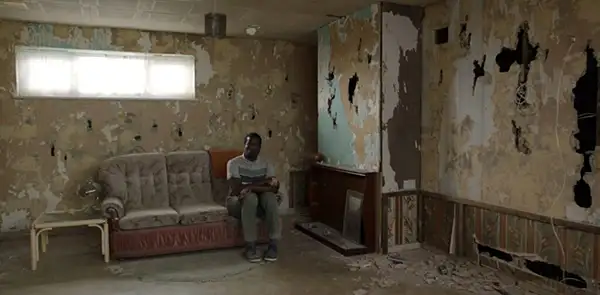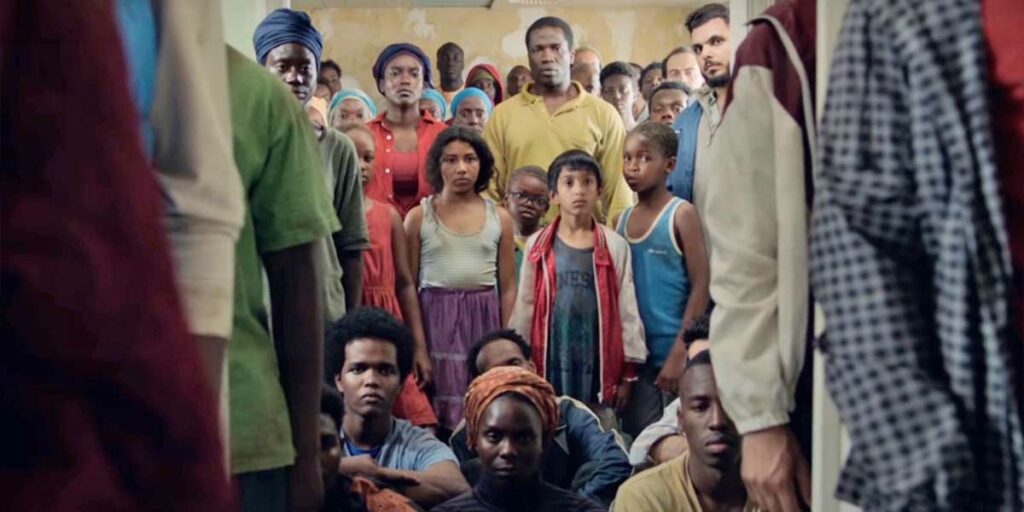A haunting exploration of the failings of the housing system, His House (2020) is a captivating modern horror classic.
Author: Lauren Chadwick
Modern horror extraordinaire His House (2020) is the debut film of director and writer Remi Weekes, chartering the journey of South Sudanese refugees to the U.K. The film stars Wunmi Mosaku and Sope Dirisu as husband and wife Rial and Bol. Escaping their war-torn home, Bol and Rial embark on a journey of displacement and survivor’s guilt. Arriving in a country full of hostility, the couple are haunted by gory ghosts and disturbing visions, whilst also being tormented by an apathetic and broken social care system.
The haunted house is a common trope within the horror genre, and can sometimes become tired with overuse, which can result in it losing power as an impactful vehicle for storytelling. His House, however, revitalises the structure of the haunted house, breathing life into it masterfully, and carving out space for an emergence of a modern, socially conscious horror where the terror lies in the world that already exists around us, one that we can astoundingly recognise. By distorting the space that is supposed to provide safety and comfort and making it malevolent, unwelcoming, and destructive, the home becomes a place in which we can examine a multitude of fears and anxieties.
The home should function to keep the evil outside, but in the haunted house, those evils accumulate and are exaggerated to communicate the pervasiveness of fear and terror. In His House, Weekes uses a brilliant allegorical retelling of this narrative structure to explore fear and terror in the experience of asylum seekers and refugees. By shining a light on displacement, survivor’s guilt, xenophobia, racism, and a litany of other damaging experiences that come with fleeing your home to find safety elsewhere, Weekes inspects the social structures and institutions that have failed individuals, families, and communities seeking refuge in the U.K.
The home afforded to Bol and Rial when they are released from a detention centre ‘as asylum seekers, not citizens’ is situated on a bleak and uninviting housing estate somewhere in Essex. Their home is bordered with a measly paved front yard littered with discarded belongings and debris. Inside, the house is furnished with faulty electrical wiring, mould, dirt, and grime that feels like it could peel off of the screen, and old pizza boxes which house swarms of insects – seemingly the only structure within this space that allows life to sustain and thrive.

Usually, the haunted house comes in the form of a grand swathing structure, Victorian or Gothic architecture, in an isolated and secluded location. The things that go bump in the night are eerie because they don’t relate to everyday objects and our everyday lives. Weekes’ use of the haunted house is the complete opposite. The setting is familiar to anyone who has unfortunately seen the worst parts of the U.K. housing crisis. It is familiar to anyone who has dealt with the hardships of claiming citizenship and to anyone who has been left to rot in a house not fit for human inhabitance. The ghosts in this film do not creep past vintage mirrors adorned in golden gilt or drag their footsteps along corridors big enough to house a family; they live in holes in the wall that expose dangerous wiring, in damp and torn down wallpaper, in bricks hitting the window from racist neighbours.
His House fills every function a modern horror should by superbly employing realism and relatability, whilst weaving in an uneasy presence of the absurd and incongruous. This is illustrated especially through Weekes’ writing. The idea of home and belonging oozes through the script and Weekes’ emotive, potent, and poignant realism communicates this phenomenally. As the ceaseless threat of the lack of belonging gathers on Bol and Rial, Bol repetitively asserts that ‘this is our home’ expressing just how desperate the fight for a place to belong is for refugees and asylum seekers.
When the ghosts climb out the walls of his living room, Bol takes a hammer and smashes the plaster. Weekes’ writing professes how deeply coveted a home is and how imperative it is to human nature to have a place where you belong. So much so, that when Rial expresses her desire to leave, Bol takes a screwdriver and tears off the handles of the windows and doors, attempting to lock them in the house forever. After the narrative climax, in which the Apeth (night witch), terrifyingly played by Javier Botet, climbs out of the floor and attacks Bol, Rial kills the Apeth, and the two (as Bol later says) ‘let’ their ghosts in to live with them. They patch up the holes with a nice rug and plaster the walls, demonstrating their desire to make this house a home.
Oscillating between the realistic language and the otherworldly presentation of the ghosts and haunting visions, His House skilfully blends old scary stories with a very corporeal and modern horror – one that is faced by so many asylum seekers and refugees. Jo Willem’s cinematography is expert throughout in crafting tension and unease in commonplace settings, especially in the scene where Rial embarks on her first venture of leaving the house. When trying to find the GP surgery, Rial finds herself in a dizzying, labyrinthian corridor of estate blocks and is met with a pernicious sense of anxiety as she travels through a current of dead ends. The camera follows her from all angles: pan shots follow Rial from behind, in front, and from the side, with dolly shots making the audience very intimately aware – and involved in – Rial’s lack of belonging.
Presented to the world in the year of the COVID-19 Pandemic, when most people had to seek shelter in their homes, His House exposes the failings of the U.K. housing system and taps into the lived experience of the underbelly of society: those without a place to call their own. Cinematic fear is crafted through a harsh and discordant non-diegetic score, jumpscares, recurring haunts of the couple’s dead daughter Nyagak, and a monstrous and ghostly Apeth. But the real fear exists in being situated within a failing home, living on only £84 a week, and the threat of deportation.
Horror should be cathartic. It should speak to the fears we all hold within us and the terror enacted both inside and outside of ourselves and His House fills this function stunningly. Standing beside socially conscious, modern horror classics such as Get Out (2017), Hereditary (2018), or The Platform (2020), His House paves a new way for modern horror, using tried and tested devices that deserve to be regenerated and allowing them to have a place in the future of the genre.
His House (2020) is now available to watch on digital and on demand.

